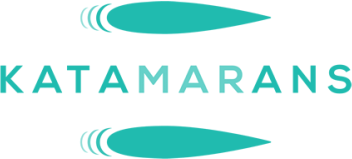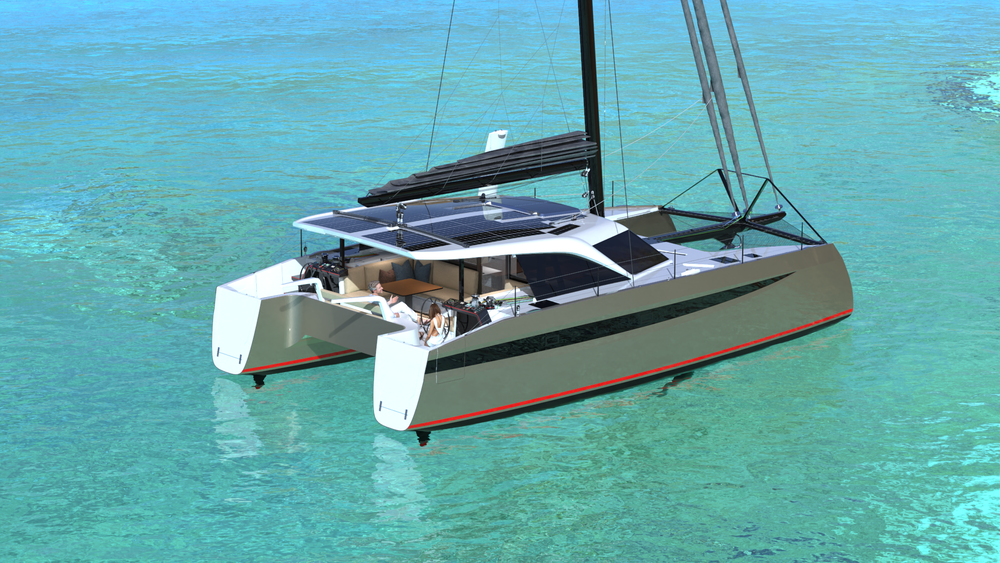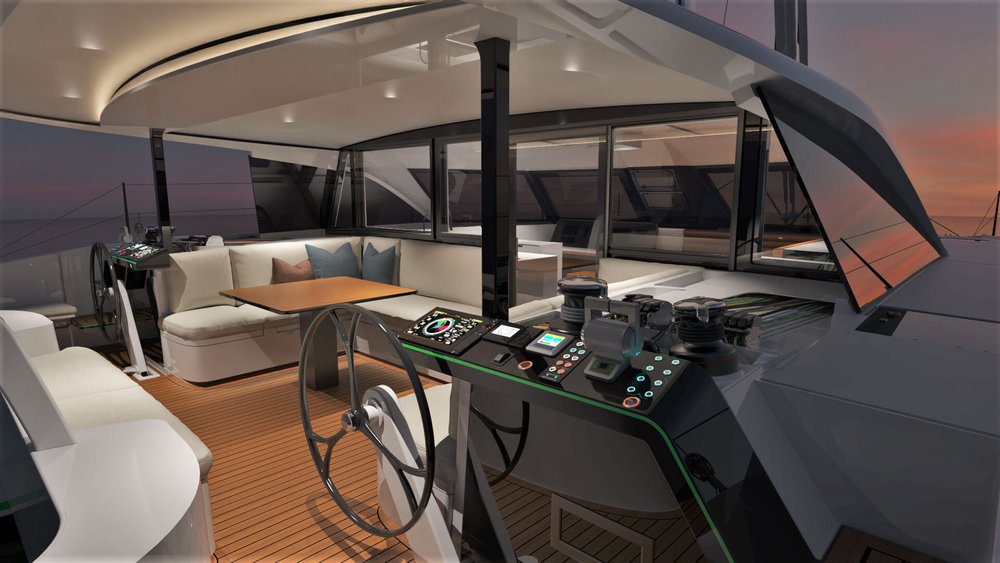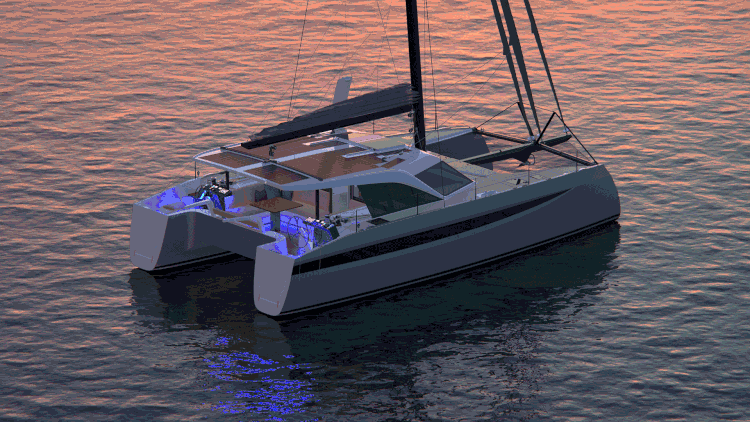Designing the HH 44
Paul Hakes (CEO & Co-Founder of HH) and James Hakes (HH Naval Architect) on how they and the team at HH Catamarans developed the all new HH44. Welcome to “Yachting Evolved.”
As part of our deeper dive of HH Catamarans, we’re going to cover their five-part mini series on their new, groundbreaking and disruptive performance catamaran: the HH44. HH are calling this “Yachting Evolved”.
We’re going to go take an in-depth look at some of the design features on this boat.
The HH44 has been designed as standard with electric propulsion and a Diesel Hybrid backup, 3,190 watts of solar, hydro power generation, swing helms, folding transoms, forward opening windows, 48 volt deck systems, shaft-drive folding propellers, pre-preg carbon fiber C-shaped daggerboards, and near wind-speed sailing performance.
Innovation
This performance cruising has been designed from the ground up as an ECO yacht with electric hybrid power and has many new features: folding transoms, swing helms, great ventilation, gorgeous finishes, great sailing performance (being part of the HH catamarans family it has that racing pedigree).
These are no compromise boats built from carbon fibre which makes them light, comfortable and safe.
No Compromise Yacht Building
This no compromise philosophy has been evident at HH from the very start of their builds and goes right through the range which started with the HH66, then the HH-50, the HH55, a 77 and now even an 88 in construction: a true superyacht
All these boats benefit from strong lightweight construction and a race pedigree. The 50s and the 55s are the most popular to date because they can be owner operated while being great boats for a family who want to cruise around the world.
But the the 50 is still a big powerful boat. There is a market out there for people who want something a little smaller.
James Hakes, Naval Architect: “..the conversation turned to, well, how small should it be? It still needs to maintain the performance characteristics of an HH catamaran but we really needed to decide what goes into it. It still has to be a world cruiser. So we started with a couple or a small family. What do they need and what do they demand of an HH catamaran in terms of luxuries, amenities, space, the features and the equipment?”
This defined their starting point and then they looked at:
– How much weight does that mean?
– What sort of hull shape are we going to need to support that payload?
A world cruiser needs a good payload: that defined the waterline length they were looking at. The beam to length ratio sits roughly between 50% and 55%. So they took the HH50 and and shrunk it down, a natural design process to follow but it didn’t work out: it was too top-heavy.
Aft Swing Helms
The HH50 has the most spectacular helm stations you could want on a cruising boat, but that design just didn’t work on the smaller model.
So they started playing around with moving the helms into the aft cockpit and this morphed to the swing aft helms. Interestingly this is something that HH launched in 2014 with their very first HH66 swing helm and it worked well. It’s interesting that many competitors have claimed it as their innovation (!)
What they’re putting in the aft cockpit of the HH44 is an off the shelf product from Jefa that really works. It’s tried and tested and many monohulls and trimarans use it: essentialy a pedestal that can swing from side to side.
Why do it? Swing it inboard to get out of the weather, swing it outboard to look down the side deck with a clear line to your sails.
Profile
Moving the helms aft gave HH a lot of freedom and flexibility to restyle. They looked at sharp windows that fully open to maximise ventilation when needed. Since they lowered the helms into the aft cockpit they decided that they needed to make things really safe so one of the most striking features of the exterior of the boat are the transoms: something not seen before on other catamarans.
This is a big part of the design. For a 44 footer, the boat actually looks a bit bigger, a bit longer and a bit sleeker. HH noticed on their other boats that washboards across the transom were a popular option. These keep the cockpit safe for children and pets and keep out following seas. When Huson Marine (who own HH) were building the Gunboats 60s it was a popular choice back then.
So for the 44, they have designed something permanent that looks great and is functional. It effectively extends the boat. Typically in a 44-foot boat sailing in the ocean you’ve got your stern and your transom steps and while sailing that’s not usable space. On the HH44 you have livable, usable space all the way to the back of the catamran. It’s almost as if you have the space of a 48 footer. Fold down the transoms at anchor and the overall length does become 48 feet. It’s a unique design in the market
Solar Power and Low Boom Power
Also moving the helms into the aft cockpit opened up the coach roof for a world leading solar installation. The HH-44 comes with 3.2 kilowatts of solar power as standard. It allows them to lower the boom, lowering the center of effort of the mainsail, so you can put more power safely into your sails without heeling. They’ve lowered the boom so that you’re getting all this power down low, which is exacltly where you want it driving the boat.
Paul Hakes (CEO): “We set about it with the design philosophy that we’re creating a boat for years to come. This isn’t a boat that that is is going to be next year’s fad, this is going to be an industry leader and that’s why we I call it highly disruptive. It’s highly disruptive in its style, its design and its technology and will be a leader in the marketplace for many years to come”.
Eco Drives
On groundbreaking technology, the biggest part of that are the eco drives. The HH44 has a parallel hybrid system: electric, quiet, fume-free propulsion at a good speed that piggybacks on reliable, trusted diesel technology. You just flick on the hybrid system giving you all the advantages of electric motoring with the reliability of diesel.
You get instant torque for maneuvering, hydro regeneration, so you’re generating electricity while you’re sailing and a big area to generate solar power.
HH are already building the first boat, infusing carbon into the first mold. Stay tuned for the next episode in the series.





